Dr. Pamela Morrison highlighted by Good Morning America for successful Vestibulodynia surgery refferal
Click here to read more.
Click here to watch the video.
For Men, Stress Often Plays a Role in Pelvic Pain – Featured article in The Paper Gown
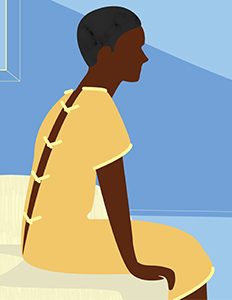 September 5, 2018 – Pelvic pain has received a fair amount of news coverage in the past few years, but stories on the issue usually focus on women. Celebrities Padma Lakshmi and Lena Dunham, for instance, have both spoken publicly about their struggles with endometriosis. Male pelvic pain, on the other hand, has largely stayed out of the cultural conversation (especially during all non-Movember months). But it’s worth talking about. Click here to read more.
September 5, 2018 – Pelvic pain has received a fair amount of news coverage in the past few years, but stories on the issue usually focus on women. Celebrities Padma Lakshmi and Lena Dunham, for instance, have both spoken publicly about their struggles with endometriosis. Male pelvic pain, on the other hand, has largely stayed out of the cultural conversation (especially during all non-Movember months). But it’s worth talking about. Click here to read more.
Dr. Pamela Morrison featured in Volume 18, Issue #5 of Practical Pain Management on The Need for Better Responses to Vulvar Pain
Click here to read more.
NVA News – Summer 2018
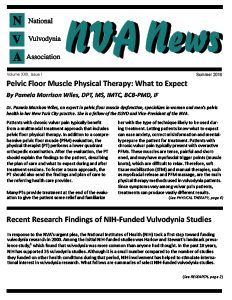 Pelvic Floor Muscle Physical Therapy: What to Expect
Pelvic Floor Muscle Physical Therapy: What to Expect
Click here to download.
Dr. Pamela Morrison comments on how many providers a patient with Vulvodynia has to see before proper diagnosis
 September 7th, 2017 – Imagine experiencing burning, stinging, and stabbing sensations in your vulva constantly or when there’s pressure or contact. Either way, this condition – known as vulvodynia – can affect every aspect of your life. Click here to read more.
September 7th, 2017 – Imagine experiencing burning, stinging, and stabbing sensations in your vulva constantly or when there’s pressure or contact. Either way, this condition – known as vulvodynia – can affect every aspect of your life. Click here to read more.
Dr. Pamela Morrison provides safety tips to Parents Magazine for moving homes during pregnancy
 July 14th, 2017 – Survive the dreaded moving day (and beyond) when you’ve got a baby on board. Here’s what’s safe, what’s not, and tips to make it all go smoothly. Click here to read more.
July 14th, 2017 – Survive the dreaded moving day (and beyond) when you’ve got a baby on board. Here’s what’s safe, what’s not, and tips to make it all go smoothly. Click here to read more.
Dr. Morrison featured in The Canadian Physiotherapy Association’s Spring Women’s Health Newsletter
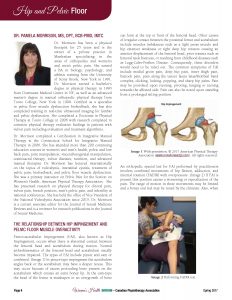 Dr. Morrison has been featured in The Canadian Physiotherapy Association’s Spring Women’s Health Newsletter. Within she discusses Femoroacetabular Impingement (FAI), also known as Hip Impingement. This painful condition occurs when there is abnormal contact between the femoral head and acetabulum during motion. Dr. Morrison discusses the symptoms, diagnosis methods, and treatments for FAI and how the pelvic floor muscles can be impacted or symptomatic. Click here to read more.
Dr. Morrison has been featured in The Canadian Physiotherapy Association’s Spring Women’s Health Newsletter. Within she discusses Femoroacetabular Impingement (FAI), also known as Hip Impingement. This painful condition occurs when there is abnormal contact between the femoral head and acetabulum during motion. Dr. Morrison discusses the symptoms, diagnosis methods, and treatments for FAI and how the pelvic floor muscles can be impacted or symptomatic. Click here to read more.
Dr. Morrison recruited, as expert, for review and editing of pelvic pain articles
Dr. Pamela Morrison’s expertise has been sought out as a peer-reviewer by scholarly journals, and also by various publications and websites. Below are some articles that Pam has recently reviewed for Practical Pain Management:
Pelvic Pain Overview
Pelvic Pain Treatments
Exams and Tests to Diagnose Pelvic Pain
Dr. Pamela Morrison, who has expertise in Vulvodynia, featured in this video
Callista Wilson began experiencing vulvodynia or vulvar pain was she was just a teenager and didn’t talk to anyone about it. Hear how after years of living with this secret, private pain, Callista is reclaiming her life and breaking the silence. To read more patient stories please visit:
http://www.nva.org/for-patients/patient-stories
Dr. Morrison on Exercise for Expectant Mothers
Dr. Pamela Morrison, PT, is featured in an informative article on PrenatalYogaCenter.com on how exercise can help—or hinder—a pregnant woman’s experience during delivery. Dr. Morrison provides valuable insights on which exercises can aid delivery by increasing flexibility and which may make delivery more difficult by tightening critical muscles and ligaments. Click here for the full article.
Lecture on the physical therapy evaluation of vulvar pain.
Dr. Pamela Morrison lectures on the physical therapy evaluation of vulvar pain, including orthopedic and pelvic floor exam, at the International Society for the Study of Vulvovaginal Diseases 2015 in front of international physicians, nurse practitioners, physician assistants, and physical therapists.
Associate Editor – Sexual Medicine Reviews, The Journal of Sexual Medicine
A recognized expert in the field of pelvic floor muscle dysfunction, pudental neuralgia, and a wide range of other disorders affecting the sexual and reproductive systems, Dr. Pamela Morrison Wiles, PT, MS, BCA-PMD, DPT, IMTC, has been named an Associate Editor of Sexual Medicine Reviews. The newly established quarterly journal distills the best evidence in the field of sexual medicine by publishing reviews and reports that synthesize the latest clinical and translational research. As Associate Editor, Dr. Morrison is responsible for reviewing papers on sexual medicine, assigning / inviting reviewers, and submitting recommendations for publication.
Featured in Journal of Women’s Health Physical Therapy
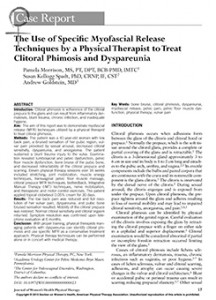 The Use of Specific Myofascial Release Techniques by a Physical Therapist to Treat Clitorial Phimosis and Dyspareunia
The Use of Specific Myofascial Release Techniques by a Physical Therapist to Treat Clitorial Phimosis and Dyspareunia
Click here to download.
Featured in NVA News, pg. 9
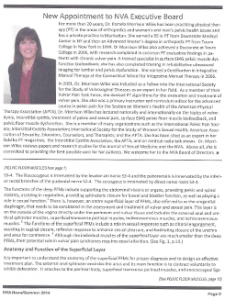 Superficial Pelvic Floor Muscles and Vulvar Pain
Superficial Pelvic Floor Muscles and Vulvar Pain
Click here to download.
Featured in Blog About Pelvic Pain (Sara K. Sauder PT, DPT), pg. 3
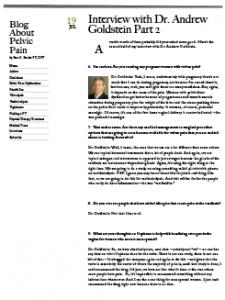
Interview with Dr. Andrew Goldstein
Click here to download.
Featured in TodayinPT.com
Pelvic Trust
When a patient presents with pain in the groin, a number of diagnoses may spring to mind. In women, it might be vulvodynia or interstitial cystitis. In men, prostatodynia, nonbacterial prostatitis or orchialgia might be suspected. In many cases, the actual cause is pudendal neuralgia, a condition that many patients suffer with for years because of its relative rarity.
The word “pudenda,” which refers to the external sexual organs, also is the Latin word for “shame.” But the real shame of PN is many patients are reluctant to seek help because of the area involved. Fortunately, there is much physical therapy can do to alleviate the pain and swelling caused by PN, although it calls for a high degree of sensitivity on the part of the therapist.
Possible Causes
Pudendal neuralgia usually is caused by one of four factors, says Stephanie Prendergast, MPT, a partner at the Pelvic Health and Rehab Center in San Francisco and Oakland, Calif. “It could be a compression issue from horseback riding or sitting,” she says. “Or it could be a tension problem related to labor and delivery or chronic constipation. There can be a visceral somatic etiology involving things like repetitive years of infections or UTIs. Or it can be caused by direct injury, such as acute surgical insult.”
PN is characterized by a sharp, shooting pain in the territory of the pudendal nerve — a symptom that can be caused by many other factors, says Prendergast. “These diagnoses do not have solid inclusion criteria, and conditions such as vulvodynia, interstitial cystitis and PN tend to have overlapping comorbidities that can lead to misdiagnosis,” she says.
Further clouding the issue is a condition called pudendal nerve entrapment, which means patients have “a clamping or squeezing of structures that cause compression of the nerve,” says Pamela Morrson, PT, DPT, BCB-PMD, IMTC, who owns a clinic in New York. “You’ll usually find it where the nerve traverses between ligaments, or through Alcock’s canal, which is made of connective tissue and part of a ligament. It can be caused by trauma, sacroiliac joint dysfunction, infections or even a stretch injury from sports.”
For the complete article, see TodayinPT.com
Featured in The Journal Of Sexual Medicine, pg. 2010
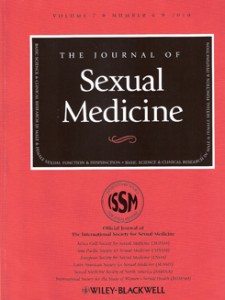
Responses To The Proposed DSM-V Changes
Click here to download.
Featured in Touro College’s School of Health and Sciences newsletter, pg. 7
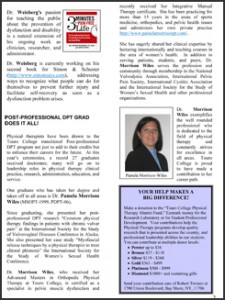
Post-Professional DPT Grad Does It All!
Click here to download.
Featured in Fit Yoga, December 2008, pgs. 32-39
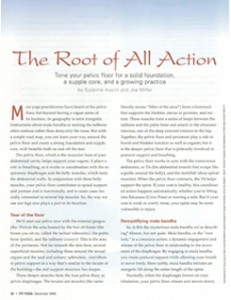
The Root of All Action
Tone your pelvic floor for a solid foundation, a supple core, and a growing practice.
By Suzanne Ausnit and Joe Miller.
Click here to download.
Featured in ICA Update Magazine, Spring 2008, pgs. 9-10
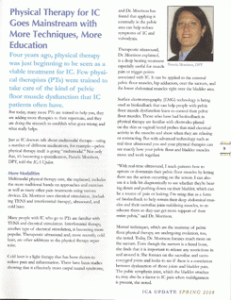
Physical Therapy for IC Goes Mainstream with More Techniques, More Education.
Click here to download the article.
Featured in Poise Magazine, January 2008
Test Your Kegel Performance at HomeBy Barbara C. Bourassa
Gynecologists, physical therapists, and bladder experts often recommend Kegel exercises for treating bladder leakage and incontinence. The theory goes as follows: Strong pelvic-floor muscles can help support the bladder and keep the urethra closed, in turn preventing bladder leakage.
Kegel exercises have been around since the 1940s, when Arnold Kegel, the gynecologist for whom Kegels are named, developed a weighted bar of stainless steel for the purpose of practicing these exercises. “This bar is cold to the touch, which actually helps a woman contract her pelvic muscles around the device,” says Stephanie Buehler, Psy.D., a licensed psychologist and certified sex therapist in Irvine, California. “As a result, she’s more likely to perform the exercises correctly.”
Since Dr. Kegel’s time, a variety of at-home Kegel devices have been produced, some of which can be found on websites such as www.kegelcompare.com. These products range from plastic, wand-like devices to oval-shaped vaginal weights and are designed to help consumers evaluate and/or improve the strength of their Kegels in the privacy of their own home.
As with any over-the-counter medical device, women should take several things into consideration when evaluating such products, experts say. As a starting point, women should assess the muscle strength of their pelvic floor. “If you can do Kegels and feel the contraction, you could possibly benefit from one of these at-home devices,” says Jen Towle, a physical therapist specializing in women’s health at Mulrenan Physical Therapy in Woburn, Massachusetts. “If you can’t feel the contraction, that’s when you might need help. The first step would be to call your doctor or consult with a physical therapist.”
It’s also best to speak with your primary-care physician, gynecologist, or other medical expert if you’re considering such a purchase. “Your physician will want to know why you’re seeking this form of self-help,” says Buehler, who often refers patients to a physical therapist for help with Kegels. “Be honest. If you’re suffering from incontinence, he or she may decide that some sessions with a physical therapist will help ensure that you’re able to perform the exercises correctly.”
If you’re set on purchasing an at-home Kegel device, keep in mind that only a few have been approved by the American Physical Therapy Association (APTA), warns physical therapist Dr. Pamela Morrison, of Pamela Morrison Physical Therapy in New York City. Such products include Stepfree Weights and a device known as the PMTx. The weights work well for many patients because they’re easy to insert, allow the patient to progress in small (ounce) increments, and can be used while lying down, sitting up, or standing.
The PMTx device uses a simple but effective pressure gauge to give the patient feedback on her “squeeze” strength. However, “this is not a scientific gauge,” Morrison notes. “And it is possible to get a false reading if you do Kegels incorrectly. But it’s also an inexpensive way of using biofeedback to give you the incentive to squeeze more.” Morrison’s practice also provides handheld biofeedback devices that patients can rent monthly as well as miniature electrodes for use at home.
Before investing in one of these devices, it’s always best to consult with your doctor as well as a physical therapist who specializes in women’s health. The American Physical Therapy Association offers a free service to help you find a physical therapist in your area; visitwww.apta.org for more information.
Featured in Poise On-line Magazine, Learning Center
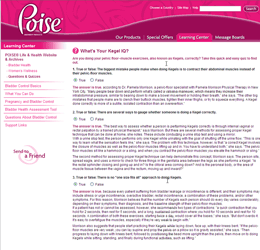
What’s your Kegel IQ?
Click here to download the article.
Featured in Today in PT, Vol. 1, Issue 1, pg.50
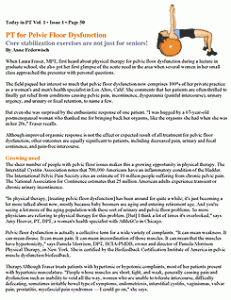
PT for Pelvic Floor Dysfunction
Core stabilization exercises are not just for seniors!
By Anne Federwisch
Click here to download the article.
Featured in Advance for Directors in Rehabilitation, Vol. 15, Issue 7, pg. 49

Branching Out
Address a growing need by adding women’s health services.
By Pamela Morrison Wiles, BA, PT, MS, DPT, BCIA-PMDB
Click here to download.
Featured in More Magazine, November 2007, Vol. 10, No. 9, pg. 212
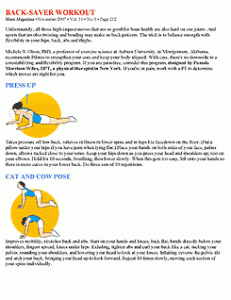
Back-Saver Workout
Click here to download.
Featured in Journal of Women’s Health Physical Therapy, Vol. 31, No. 3, Winter 2007, pgs. 7-26
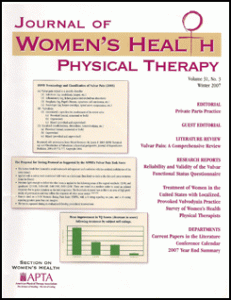
Literature Review
Vulvar Pain: A Comprehensive Review
By MJ Strauhal, PT; Jane Frahm, PT; Pamela Morrison Wiles, PT, DPT; Wendy Featherstone, BS, PT; Dee Hartman, PT; Judith Florendo, PT; and Susan Parker, PT,
Click here to download.
Presented at the International Society for the Study of Women’s Sexual Health, February 2006
The Use of Specific Myofascial Release Techniques by a Physical Therapist to Treat Clitoral Phimosis: A Case Report
By Pamela Morrison, DPT, BCIA-PMDB, IMTC, Andrew Goldstein, MD, Susan Kellogg-Spadt, CRNP, PhD
Background: Clitoral phimosis is a condition characterized by adherence of the clitoral prepuce to the surface of the clitoral glans. It can be a result of scarring from inflammatory dermatitis or dermatoses, hormonal deficiencies, physical trauma, and inadequate hygiene practices. The purpose of the following case study is to describe the medical history, physical examination and interventions used to identify and treat clitoral phimosis for one patient. Conservative treatment such as myofascial release techniques employed by a physical therapist was paramount in the resolution of FSD and painful symptoms for this patient with clitoral phimosis.
Case Description: The patient was a 41-year-old female who had chief complaints of chronic constant low back pain; vulvar pain provoked by sexual arousal; decreased clitoral sensitivity; painful intercourse and decreased ability to achieve orgasm for a period of 6 years. Her dyspareunia was rated on a Numeric Pain Rating Scale (NPRS) as 2/10; her low back pain was rated 4/10. The patient noted that sentinel events for the original onset of symptoms were a cesarean section delivery followed by a tubal ligation. Subsequently, the patient sustained a blunt trauma injury to the vulva which resulted in exacerbation of vulvar swelling and pain. Physical exam revealed lumbosacral and pelvic dysfunction, moderate to severe pelvic muscle floor pain, tight introitus, and decreased retractability of the clitoral prepuce with noted scarring. The patient attended 11 physical therapy sessions over a period of 16 weeks. Physical therapy (PT) treatment included stretching, joint mobilization, muscle energy techniques, transvaginal pelvic floor and direct clitoral prepuce myofascial release, biofeedback, and therapeutic exercises. These techniques were performed in conjunction with medical management which included daily application of topical clobetasol 0.05% cream for 30 days.
Results: The patient’s low back pain improved from 4/10 to 1/10 and changed from a daily unremitting quality to an intermittent one. The patient had resolution of her vulvar pain and was able to engage in painfree intercourse. The phimosis resolved with complete restoration of mobility of the clitoral prepuce. Normal clitoral sensitivity and the ability to experience clitoral orgasm returned. The patient reported continued symptom resolution upon telephone evaluation at 6 months post treatment.
Conclusion: With proper training, physical therapists treating vulvar pain syndromes may be able to identify clitoral phimosis and use specific myofascial release techniques as a conservative treatment approach. PT techniques for clitoral phimosis can be performed as a sole intervention or in concert with traditional medical therapy.
Presented at the Integrative Manual Therapy Scientific Symposium, Bloomfield Connecticut, March 2007
Treatment of Infertility and Pelvic Adhesions With Manual Physical Therapy And Integrative Manual Therapy: A Case ReportBy Pamela Morrison, DPT, BCIA-PMDB, IMTC
ABSTRACT
Purpose: Infertility affects millions of women. After age 35, chances of conceiving significantly decrease. Women are seeking alternative ways to treat infertility or improve their chances of successful in vitro fertilization (IVF). Use of integrative manual therapy techniques incorporated into manual physical therapy treatment is an alternative approach that may prove effective. The purpose of this case report is to describe the manual physical therapy and integrative manual therapy (IMT) interventions employed to manage a patient with infertility and pelvic scar tissue adhesions or microadhesions.
Case description: This is a case report of a 43- year-old female whose chief complaints were inability to conceive, failure of IVF, pelvic scar tightness and pain, and pelvic swelling. An ectopic pregnancy, L-sided laparoscopic oopherectomy and salpingectomy, pelvic sepsis, and open pelvic exploratory surgery had occurred in the past. The patient had undergone 7 treatment sessions.
Physical Examination and Intervention: Tenderness was revealed upon palpation of all sacral segments, right inferior pelvic region, and at the suprapubic scar region. Other findings included a pelvic obliquity, decreased range of motion of the spine and hips, abdominal bloating, visceral restrictions, decreased lower quarter flexibility, and a sacral malalignment. IMT evaluation myofascial mapping exam revealed emotional issues, physical functional medicine issues, pelvic bowl involvement, sacral segments and sacroiliac involvement, and right hip involvement. IMT techniques such as myofascial release, fascial scar strands, bone bruise technique, viscera, and neuralfascial process were utilized.
Outcomes: Following 7 treatments, the patient underwent a follow-up ultrasound which revealed that her uterine lining had increased from 7-8mm to 11mm. Despite having elevated natural killer (NK) cell levels, IVF with a donor egg resulted in a physical pregnancy that miscarried at 9 weeks due to two trisomies. After 8 more sessions, a successful IVF with donor egg and pregnancy resulted in the birth of her healthy son.
Discussion and conclusion: Manual physical therapy with use of integrative manual therapy techniques may be another alternative treatment option for women with infertility issues and striving for successful IVF outcomes.
Presented at the International Society for the Study of Vulvovaginal DiseasesConference, Alaska, August 2007
Common Physical Therapy Evaluation Findings in Women with Chronic Vulvar Pain: A Preliminary StudyBy Pamela Morrison, PT, MS, DPT, BCIA-PMDB, IMTC
Objective: The objective of this study was to identify and describe the common physical therapy evaluative findings in women with chronic vulvar pain (CVP).
Methods: A detailed retrospective chart review was performed on 25 female physical therapy patients with CVP who were evaluated between 2004 and 2006. A standardized clinical evaluation protocol and an extensive interview were used to obtain clinical characteristics and findings.
Results: All of the patients were female, Caucasian with a median age of 40.2 years ranging from 24 to 62 years. The majority of the patients were given the diagnosis of Vulvodynia (28%), Pelvic Floor Dysfunction (24%), or Vulvodynia with Pelvic Floor Dysfunction (12%). Most of the patients reported having penetration pain (96%) and many experienced pain with sitting (40%). 64% had moderate to severe pain on the Numeric Pain Rating Scale (NPRS). All of the patients (100%) demonstrated a pelvic obliquity. Large deficits were noted for active range of motion of the thoracolumbar flexion (76%) and lateral flexion (76%) and rotation (60%). 60% of the patients demonstrated an L5 positional or mobility dysfunction. Pubic symphyseal malalignment occurred in 56% of the patients and 84% demonstrated sacroiliac joint dysfunction. 60% demonstrated coccyx pain on palpation, a coccyx positional and/or mobility dysfunction. Passive range of motion was decreased for hip flexion in 64% of the patients. 52% of the patients demonstrated decreased passive hip internal rotation and 64% had limited hip external. 92% demonstrated hip abduction deficits. 96% of the patients demonstrated decreased bilateral lower quarter flexibility. Suprapubic or abdominal surgical scars were noted in 28% of the patients and episiotomy scars were present in 28%. Both types of scars were present in 8% of the patients. Viscera mobility restrictions were noted in 88% of the patients. Cotton swab vestibule testing revealed that 60% of the patients had moderate to severe pain in the vulvar vestibule. Pelvic floor muscle (PFM) manual muscle testing revealed that 68% demonstrated weakness. None demonstrated ideal strength of 5/5. Excluding 5 patients, the remaining 68% had an intravaginal PFM surface electromyography (sEMG) average resting measure of greater than 2.0 uv taken over 120 seconds. The minimum sEMG measure was 0.0 uv and the maximum was 9.42 uv. The mean was 4.2 uv. Many of the patients demonstrated palpation pain of the right pubococcygeus (68%), left pubococcygeus (76%), right iliococcygeus (56%), left ilococcygeus (68%), right coccygeus (40%), left coccygeus (52%), right obturator internus (52%), left obturator intemus (60%). Most trigger points were found in the puborectalis muscles (20%), right pubococcygeus (4%), and left iliococcygeus (4%).
Conclusion: Describing normative physical therapy evaluation data for patients with CVP may help to establish more efficient and thorough evaluations for physical therapists and therefore, better enable them and physicians to recommend and implement effective treatment interventions. Prior to considering more invasive treatment for patients with vulvar pain, a physical therapy evaluation should be considered.
Featured in a press release, November 30, 2007
Women With Vulvodynia can Find Relief wth Physical Therapy
By the American Physical Therapy Association
ALEXANDRIA, VA, November 30, 2007 — Many women with vulvodynia, an unexplained pain or discomfort in the vulva can find relief with physical therapy, according to the American Physical Therapy Association (APTA).
Vulvodynia, which affects an estimated 14 million American women*, is characterized by rawness, itchy, burning, throbbing or tenderness in the area around the opening of the vagina. Frequently not discussed because of its intimate nature, vulvodynia can greatly affect the lives and personal relationships of women of all ages, races, and ethnicity.
“Women should understand that it is not common, nor should they expect to experience debilitating pain when they are sexually active, use a tampon, or even wear tight-fitting jeans,” said physical therapist Pamela Morrison, PT, MS, DPT, BCIA-PMDB, IMTC. Morrison specializes in women’s health physical therapy at Pamela Morrison Physical Therapy in New York City, New York.
“Women who experience pelvic pain and discomfort will typically consult first with their general practitioner or gynecologist,” Morrison notes. However, some doctors may not be familiar with the terms vulvodynia, vaginismus (vaginal muscle spasm with any kind of attempted penetration), or vulvar vestibulitis (vulvar pain local to the vaginal opening), she said. “If we can teach women with pelvic pain – either during intercourse or all the time – just one thing, it would be for them to know their options for medical treatment and to be their own best advocates when it comes to pelvic health.”
“A physical therapist trained in treating pelvic floor muscle dysfunction will obtain a comprehensive medical history from a patient, as well as conduct both an internal and external examination,” said Erin Hytrek, DPT, a physical therapist specializing in women’s health at Physical Therapy Specialists, PC, in Sioux City, Iowa. Physical therapists can work with patients by using gentle manual manipulation to, soften, and lengthen muscles, both intra vaginally and intra rectally along with other techniques aimed at treating weakness, tension and pain.
Morrison notes that causes for pelvic floor muscle dysfunction can include muscle pain, weakness, incoordination, spasm or result from tearing during childbirth, and that physical therapist treatment can also include therapeutic ultrasound, electrical stimulation, and biofeedback.
“Another vital service that physical therapists provide to women who experience pelvic pain is patient education,” notes physical therapist Dee Hartmann, PT, owner of Dee Hartmann Physical Therapy for Women in Chicago, Illinois. “Ninety-eight percent of my patients have vulvodynia, with varying degrees of pain around the vulva and vagina. I can’t tell you how many times they had been previously told by other doctors that their symptoms were psychosomatic or, most likely, a yeast infection.” Hartmann noted that most of her patient’s pain is significantly diminished, if not eradicated, in 7-15 weeks of once-weekly treatment.
Consumers can download information regarding pelvic pain and how physical therapists can help at www.apta.org/consumer.
Physical therapists are health care professionals who diagnose and manage individuals of all ages, from newborns to elders, who have medical problems or other health-related conditions that limit their abilities to move and perform functional activities in their daily lives. Physical therapists examine each individual and develop a plan of care using treatment techniques to promote the ability to move, reduce pain, restore function, and prevent disability. Physical therapists also work with individuals to prevent the loss of mobility by developing fitness- and wellness-oriented programs for healthier and more active lifestyles.
The American Physical Therapy Association (www.apta.org) is a national organization representing more than 73,000 physical therapists, physical therapist assistants, and students nationwide. Its goal is to foster advancements in physical therapist education, practice, and research. Consumers can access “Find a PT” to find a physical therapist in their area, as well as physical therapy news and information at www.apta.org/consumer.
*The National Institutes of Health (NIH)
Featured on HealthNewsDigest.com, December 5, 2007
Women with Vulvodynia Can Find Relief with Physical TherapyBy American Physical Therapy Association
HealthNewsDigest.com – ALEXANDRIA, VA — Many women with vulvodynia, an unexplained pain or discomfort in the vulva can find relief with physical therapy, according to the American Physical Therapy Association (APTA) …(excerpted)
Consumers can download information from APTA’s Section on Women’s Health regarding pelvic pain and how physical therapists can help at http://www.apta.org/consumer






